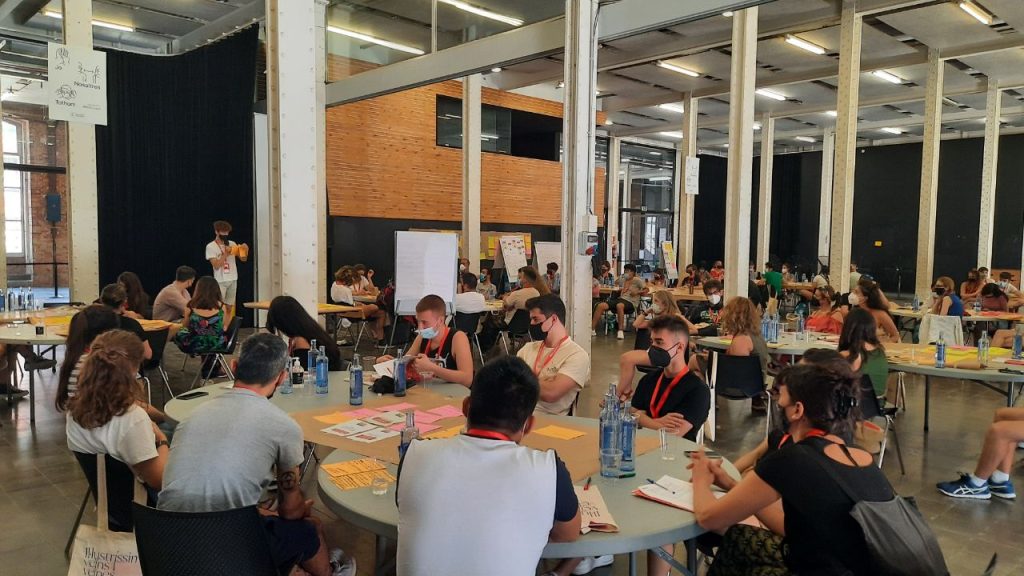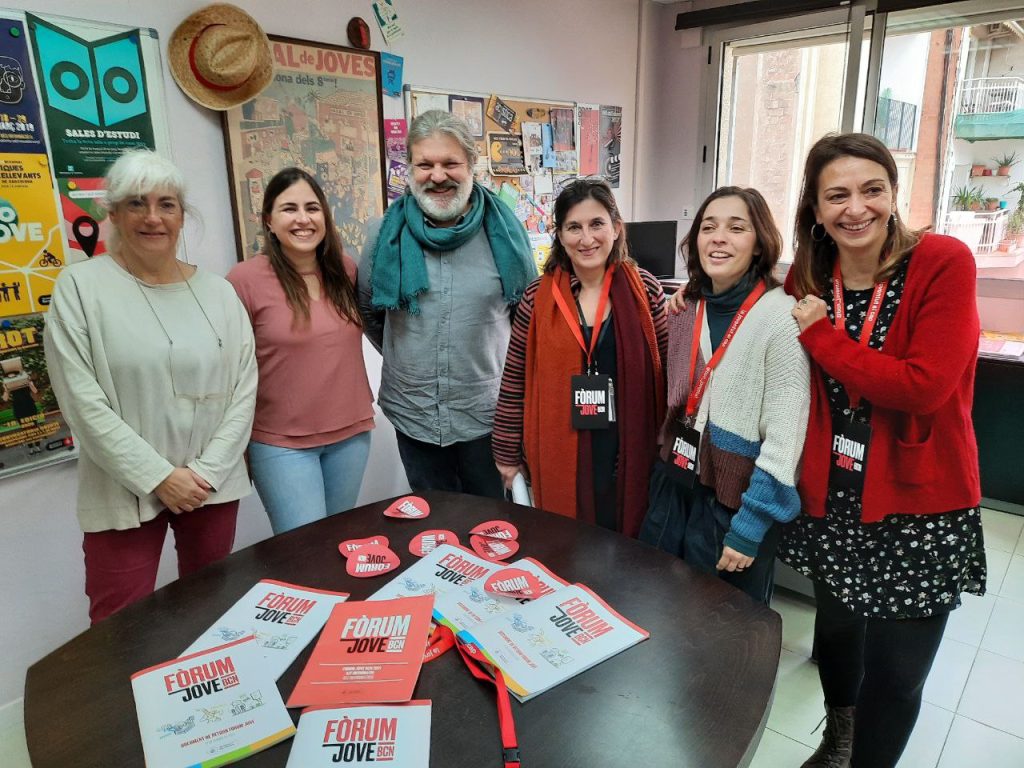Barcelona has a dedicated citizen’s assembly and has had a specialist team within the city council, Active Democracy (Democracia Activ), for the last 8 years. Democracy Technologies spoke with two members of this team – Orlando Blasco Aleu and Inma Rodriguez Sanchez. Both of whom were involved in the youth participation process, Barcelona Youth Forum.
How can local government help the youth of Barcelona live their best lives?
This question is at the core of a participatory project focused on young people, aged 16 to 29, living in Barcelona. The impact of Covid 19 on the youth was particularly strong. The arrest of well-known Catalan rapper, Pablo Hasél, in February 2021 also played a role in heightening feelings of anger and alienation among the youth, explains Orlando. This is the first time the local government focused specifically on youth participation.
Step one: Finding a representative group of dedicated participants
The first phase of the project began in July 2021. Working with a consultancy firm that specializes in deliberative participation projects, three teams within the municipal government were involved. They were Active Democracy, the Democratic Innovation and the Youth department. First step, reaching out to the youth of Barcelona in order to find a representative group of participants. Inma explains that between 20 000 and 40 000 letters was the recommended number. They sent 20 000 and received 1600 replies. This is a little over a 5% response rate.
In order to achieve a representative sample, the initial outreach was carefully controlled for age, gender, municipal district and socio-economic level. In the next stage, they used what Inma terms a lottery method, also known as sortition, in order to make the final selection. Once they had a group of 99 participants, the team called each one via telephone. They explained the proposed process in order to make clear the commitment required. “This part was really quite complicated and intense” admits Inma.
The process involved 8 sessions of four hours each, over a period of 4 months with a two-month summer break in the middle. To ensure continuity of commitment and control for higher attrition rates for those from less affluent backgrounds, remuneration of €9 per hour was offered to all participants.
Step 2: Topic selection – what concerns the youth of Barcelona?
The young participants raised various topics of interest. Mental health, education, emancipation, discrimination, environment, culture and housing are all key concerns for youth. Initially, they planned to explore each one separately but for practical reasons, they later decided to focus on just 3 broad themes. These were Mental Health, Education and Independence (relating to jobs and accommodation). Even three themes proved to be a logistical challenge, admits Orlando.
Step 3: The deliberation phase – time to talk!
Participants were divided into smaller groups of nine or ten people, for the deliberation phase of the project. This ran during October and November, 2021. Each group had two facilitators and experts were brought in to inform participants on different issues relating to the chosen themes. Initially, they had planned for all groups to discuss all three themes. But again, they found that there simply wasn’t enough time in which to do this. So groups were allocated one of the three themes. This meant that approximately 30 participants were involved in the discussion of each theme.

What about digital participation?
On the digital side, two separate online platforms were used – a new approach. Barcelona-based participatory platform, decidim designed and implemented both. The open platform was available to the wider public and was there to provide transparency and accountability. Videos of the different sessions along with documentation and final proposals were all posted there.
This platform is still being used now to follow up and track progress on accepted proposals. The other, was a private platform, for sole use by participants. They used the platform in addition to face-to-face participation channels. The public platform is not interactive but has received a high number of visitors – over 8500 visitors so far. The private platform was less well used, admits Inma.
“We noticed, as with real-life participation, that there are those who get involved and those who don’t – it’s exactly the same online” explains Inma. The difference is that online one can see very clearly how many have participated and when – it is more easily measured. In spite of what we might expect, higher online participation by younger people is not a given in these initiatives. Older participants who are truly devoted to a cause, show higher levels of participation and commitment than the youth. “It really comes down to interest levels,” says Inma.
Lessons learnt along the way
“Something of which we are particularly proud is our success in maintaining a diversity of participants throughout,” says Orland. This is in spite of the fact that drop-out rates amongst the youth were found to be higher than the population as a whole. For this reason, Inma stresses the importance of having a sizable reserve list of participants when planning a youth participation process like this one. Inma recommends around 125 participants in order to maintain 99 participants in the deliberative assembly.
Orlando stresses the importance of a cohesive, truly dedicated team for success. Youth participation projects like these involve constant change and adjustment. The work is intense and involves long, late hours and lots of problem-solving. So the team really has to pull together he says.
It is also essential to take care of the participants from the first day to the last. It is important to provide personalized treatment when needed. Be aware of their needs so that everyone feels comfortable, explains Inma. To this end, they had a dedicated team member for whom this was pretty much a full-time job.
Finally, it is important to understand that initiatives like these take substantial amounts of time and resources. “This is not a cheap process” says Inma, “so there has to be strong political will behind it”. Managing political expectations is also part of the process. “The politicians are always there in the background, wanting results and a photo,” explains Orlando with a smile.

Step 4: Final proposals & implementation – what do the youth of Barcelona really want from local government?
At the end of the process, participants agreed on a list of 22 proposals, which went to the city council. 20 of them are being implemented. Inma believes that the young people who have followed the whole process are satisfied with the degree of commitment displayed by the city council. However, she agrees that the true test will come with their implementation and durability going forward.
Perhaps surprisingly, given the information age in which we live, the biggest request from participants was a desire for more dedicated information relating to all three topics under discussion. The resulting proposal: a high-quality communication campaign dedicated to Barcelona youth that will allow them to stay informed on issues concerning jobs, housing and educational opportunities. The creation of such a campaign on social media platforms like TikTok, Twitter and Instagram, led by young influencers, is currently underway and will go live this spring.
A new vocational training office, aimed at youth has also been opened and various services dedicated to young people have been expanded across the city. The creation of dedicated WhatsApp groups, designed to address mental well-being is also being rolled out. Many young people continue to struggle with the mental health fallout created by the pandemic. It is often easier to take that first tentative step for help via a Whatsup message rather than a telephone call or face-to-face meeting, explains Inma.
Happy with achievements
“We are happy with what has been achieved” says Orlando. Although the future of their work is uncertain. Local elections take place across Spain in May and national elections in September. If a new government is elected that does not support these types of programmes, then their work may be interrupted. Here’s hoping it’s not!